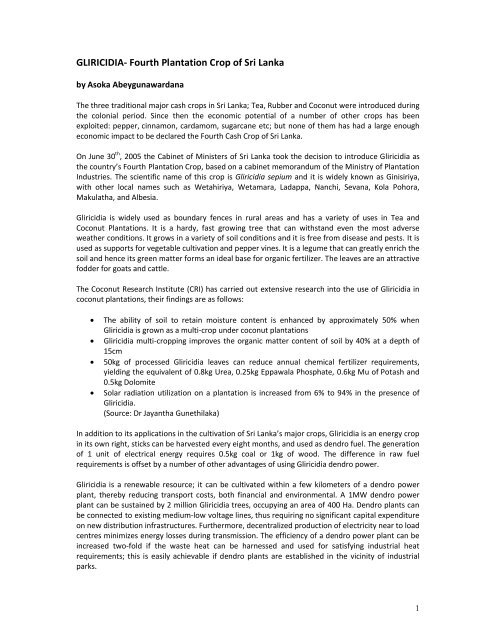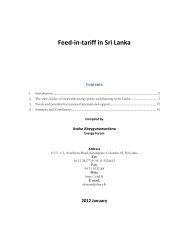6 Gliricidia - Energy Forum - Sri Lanka
6 Gliricidia - Energy Forum - Sri Lanka
6 Gliricidia - Energy Forum - Sri Lanka
Create successful ePaper yourself
Turn your PDF publications into a flip-book with our unique Google optimized e-Paper software.
GLIRICIDIA- Fourth Plantation Crop of <strong>Sri</strong> <strong>Lanka</strong><br />
by Asoka Abeygunawardana<br />
The three traditional major cash crops in <strong>Sri</strong> <strong>Lanka</strong>; Tea, Rubber and Coconut were introduced during<br />
the colonial period. Since then the economic potential of a number of other crops has been<br />
exploited: pepper, cinnamon, cardamom, sugarcane etc; but none of them has had a large enough<br />
economic impact to be declared the Fourth Cash Crop of <strong>Sri</strong> <strong>Lanka</strong>.<br />
On June 30 th , 2005 the Cabinet of Ministers of <strong>Sri</strong> <strong>Lanka</strong> took the decision to introduce <strong>Gliricidia</strong> as<br />
the country’s Fourth Plantation Crop, based on a cabinet memorandum of the Ministry of Plantation<br />
Industries. The scientific name of this crop is <strong>Gliricidia</strong> sepium and it is widely known as Ginisiriya,<br />
with other local names such as Wetahiriya, Wetamara, Ladappa, Nanchi, Sevana, Kola Pohora,<br />
Makulatha, and Albesia.<br />
<strong>Gliricidia</strong> is widely used as boundary fences in rural areas and has a variety of uses in Tea and<br />
Coconut Plantations. It is a hardy, fast growing tree that can withstand even the most adverse<br />
weather conditions. It grows in a variety of soil conditions and it is free from disease and pests. It is<br />
used as supports for vegetable cultivation and pepper vines. It is a legume that can greatly enrich the<br />
soil and hence its green matter forms an ideal base for organic fertilizer. The leaves are an attractive<br />
fodder for goats and cattle.<br />
The Coconut Research Institute (CRI) has carried out extensive research into the use of <strong>Gliricidia</strong> in<br />
coconut plantations, their findings are as follows:<br />
<br />
<br />
<br />
<br />
The ability of soil to retain moisture content is enhanced by approximately 50% when<br />
<strong>Gliricidia</strong> is grown as a multi-crop under coconut plantations<br />
<strong>Gliricidia</strong> multi-cropping improves the organic matter content of soil by 40% at a depth of<br />
15cm<br />
50kg of processed <strong>Gliricidia</strong> leaves can reduce annual chemical fertilizer requirements,<br />
yielding the equivalent of 0.8kg Urea, 0.25kg Eppawala Phosphate, 0.6kg Mu of Potash and<br />
0.5kg Dolomite<br />
Solar radiation utilization on a plantation is increased from 6% to 94% in the presence of<br />
<strong>Gliricidia</strong>.<br />
(Source: Dr Jayantha Gunethilaka)<br />
In addition to its applications in the cultivation of <strong>Sri</strong> <strong>Lanka</strong>’s major crops, <strong>Gliricidia</strong> is an energy crop<br />
in its own right, sticks can be harvested every eight months, and used as dendro fuel. The generation<br />
of 1 unit of electrical energy requires 0.5kg coal or 1kg of wood. The difference in raw fuel<br />
requirements is offset by a number of other advantages of using <strong>Gliricidia</strong> dendro power.<br />
<strong>Gliricidia</strong> is a renewable resource; it can be cultivated within a few kilometers of a dendro power<br />
plant, thereby reducing transport costs, both financial and environmental. A 1MW dendro power<br />
plant can be sustained by 2 million <strong>Gliricidia</strong> trees, occupying an area of 400 Ha. Dendro plants can<br />
be connected to existing medium-low voltage lines, thus requiring no significant capital expenditure<br />
on new distribution infrastructures. Furthermore, decentralized production of electricity near to load<br />
centres minimizes energy losses during transmission. The efficiency of a dendro power plant can be<br />
increased two-fold if the waste heat can be harnessed and used for satisfying industrial heat<br />
requirements; this is easily achievable if dendro plants are established in the vicinity of industrial<br />
parks.<br />
1
When all factors are considered, <strong>Gliricidia</strong> energy would be a cheaper alternative to coal energy.<br />
<strong>Gliricidia</strong> cultivation can easily be adopted by farmers, integrating it with the existing agricultural<br />
pattern. An out-grower system, modeled on the system currently in wide-spread use within the<br />
sugar and tea industries, would be the ideal mechanism for dendro power plants, providing a greater<br />
margin of profit to the industry. Small-scale home gardens island-wide can supply <strong>Gliricidia</strong> wood to<br />
decentralized power plants<br />
Introducing <strong>Gliricidia</strong> to the community agro forestry programs of the Forest Department is also<br />
possible. National land use statistics indicate the availability of more than 1,700,000 Ha of degraded,<br />
unproductive, sparse and abandoned lands, mostly in the dry zone. These areas could readily be<br />
used for the establishment of <strong>Gliricidia</strong> plantations. The potential for establishing <strong>Gliricidia</strong><br />
plantations is enormous and the Government has entrusted the Coconut Cultivation Board with the<br />
responsibility of promoting <strong>Gliricidia</strong> as the 4 th plantation crop in <strong>Sri</strong> <strong>Lanka</strong>. In addition, the<br />
government has taken steps to establish the <strong>Sri</strong> <strong>Lanka</strong> Sustainable <strong>Energy</strong> Authority (SLSEA) to<br />
remove barriers for mainstreaming renewable energy technologies including Dendro power.<br />
Accordingly SLSEA has introduced a cost reflective power purchasing tariff for Dendro power inviting<br />
private sector firms to establish dendro power plants.<br />
Despite these Government initiatives, <strong>Gliricidia</strong> has not thus far earned its designation as 4 th<br />
plantation crop of <strong>Sri</strong> <strong>Lanka</strong>. It is necessary look back and examine what has happened in the<br />
<strong>Gliricidia</strong> plantation sector since June 2005. To be frank, the impact of <strong>Gliricidia</strong> is minimal. What<br />
are the issues behind this lack of progress, and how can they be addressed?<br />
In order to promote using <strong>Gliricidia</strong> leaves as a substitute to chemical fertilizer it is important to give<br />
a part of the chemical fertilizer subsidy for using <strong>Gliricidia</strong> leaves as organic fertilizer. To popularize<br />
<strong>Gliricidia</strong> as an animal feed it is necessary to discourage the importation of milk and to provide<br />
incentives for cattle rearing. The private sector is reluctant to establishing dendro power plants<br />
without having a guaranteed fuel wood supply. Farmers are reluctant to establish <strong>Gliricidia</strong><br />
plantations with having a guaranteed market for fuel wood. Like the Chicken and Egg situation:<br />
which comes first?<br />
The government should intervene at this stage. The first step is to establish the inter-ministerial unit<br />
comprising the secretaries of the Ministry of Power and <strong>Energy</strong>, Ministry of Agriculture Land<br />
Irrigation, Ministry Rural and Small Scale Industries, and the Ministry of Plantation Industries to<br />
determine policy directives, to monitor the project and to formulate effective institutional<br />
framework for utilization of crops, as recommended by the cabinet in June 2005. Further the<br />
government should implement the cabinet decision which highlighted the need for the government<br />
to obtain foreign donor assistance for cultivation and power generation and distribution.<br />
It is important for the state owned plantation companies to recognize the emerging market for<br />
<strong>Gliricidia</strong> wood and leaves and to invest on establishing <strong>Gliricidia</strong> as a multi crop. The state owned<br />
agricultural extension services should be properly used to propagate the message of <strong>Gliricidia</strong> being<br />
the fourth plantation crop of the country, highlighting the benefits to farmers.<br />
Having an integrated plan for promoting <strong>Gliricidia</strong> as the fourth plantation crop is essential for the<br />
country to ensure water, food and energy security. There is no other way for <strong>Sri</strong> <strong>Lanka</strong> to face the<br />
global water, food and energy crisis of the coming decade. The cabinet decision was a timely move;<br />
unfortunately there was no follow up program for realizing the goal of making <strong>Gliricidia</strong> the fourth<br />
plantation crop. We have already wasted four valuable years since the cabinet decision. We cannot<br />
further postpone this initiative; we must act fast.<br />
2





